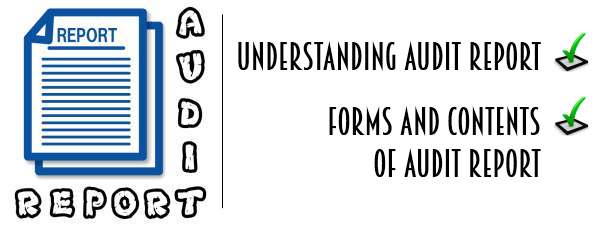Understanding Audit Report | Forms and Contents of Audit Report
Table of Contents
Understanding Audit Report
The auditor’s report is the end product of each audit. Audit report is considered as and important channel through which opinions of an auditor about the financial statements and the findings of the company audited by him are expressed. The audit report summarizes the outcome of the audit work done by the auditor. Hence it is an important part of the audit process.

Auditor collects evidences about financial statements or other propositions covered by audit through different methods. Gathered evidences are sifted and examined by the auditor with due care, diligence, skill, etc. Finally, he drew appropriate conclusions and conveys them through the audit report. The auditor should be careful about the language and the words, which he uses, in the audit report because it is on them the auditor’s legal responsibility for negligence or fraud rests.
The AAS 28 establishes standards on the form and content of the auditor’s report. The Companies Act also lays down the requirement of an audit report. The auditor is expected to prepare his audit report based on these standards and requirements. In this chapter, we shall describe the form, contents and types of audit report.
Form and Contents of Audit Report
As per the AAS 28, the audit report should contain the following basic elements in it:
- Title of the Report.
- Addressee.
- Opening or Introductory Paragraph.
- Scope Paragraph.
- Opinion Paragraph.
- Signature.
- Place of Signature.
- Date of the Report.
1. Title of the Report
The title of the report should be appropriate i.e., Auditor’s Report, Cost Auditor’s Report, etc. It enables the readers to identify the auditor’s report and also distinguish it from the reports of others such as director’s report, accountant’s report, etc.
2. Addressee
The auditor’s report should be addressed to the person to whom it should be forwarded. Generally, it is submitted to the person who appoints the auditor. Hence, the addressee is a person who appoints the auditor and to whom the report is forwarded. In case of the statutory audit of a company, it is the shareholders who are the addressee.
3. Opening or Introductory Paragraph
It consists of the identification of the following aspects:
- Financial Statements Audited: Financial statements are identified by name of the company and the period covered by the financial statements.
- Clear Marking of Responsibility between the Management and the Auditor: It should state clearly that the financial statements are the responsibility of the entity’s management and that the responsibility of the auditor is to express an opinion thereon.
4. Scope Paragraph
The scope paragraph should specify the nature and scope of the work performed by the auditor. It should state that the audit was conducted as per the auditing standards generally accepted in India and that the audit was planned and performed to obtain assurance that the financial statements are free of material misstatement.
Then it should specifically describe the audit as including — an examination, on a test basis, of evidence supporting the financial statements, assessment of accounting principles followed and of significant estimates made by the management, and overall evaluation of financial statement presentation. Besides, it should also state that the audit provides a reasonable basis for the auditor’s opinion.
5. Opinion Paragraph
The opinion paragraph of the auditor’s report should clearly specify the financial reporting framework such as accounting principles generally accepted in India used to prepare the financial statements and state the auditor’s opinion as to whether the financial statements give a true and fair view in accordance with that financial reporting framework and whether they comply with the statutory requirements.
6. Signature
The auditor in his personal name should sign the auditor’s report. The audit report should be signed in the personal name of the auditor and also in the name of the audit firm if it was appointed as the auditor. While signing the report, the membership number of the partner or proprietor, assigned by ICAI should be mentioned.
7. Place of Signature
The report should specify the location, where the audit report is signed. That is the town or city where the report is signed should be mentioned specifically here.
8. Date of the Report
The date of auditor’s report on financial statements indicates the date when the report is signed by the auditor with his views and opinions about the financial statements of the company he audited. This gives a clear picture that the auditor has considered the effect, on the financial statements and on the audit report, of the events and transactions that occurred, and of which the auditor became aware, up to that date. Further, the auditor report should not predated than the date on which the financial statements are signed or approved by the management.
